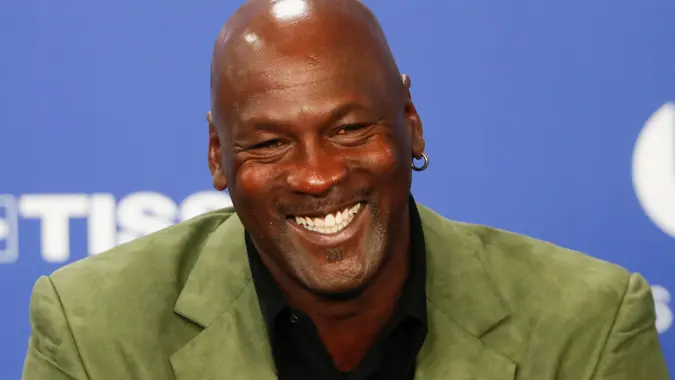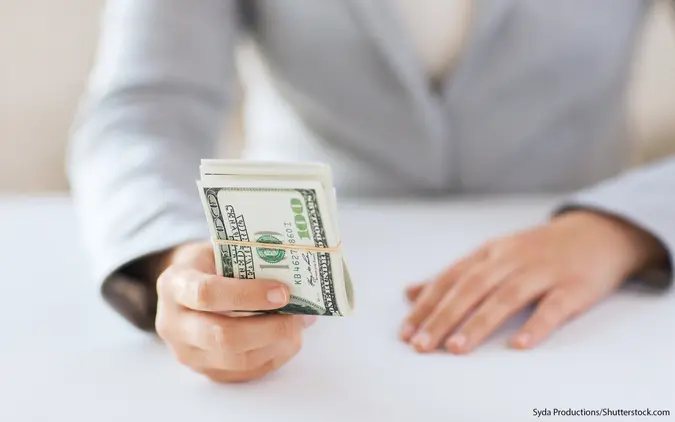6 of Jeff Bezos’ Risk-Taking Secrets That Anyone Can Use

Commitment to Our Readers
GOBankingRates' editorial team is committed to bringing you unbiased reviews and information. We use data-driven methodologies to evaluate financial products and services - our reviews and ratings are not influenced by advertisers. You can read more about our editorial guidelines and our products and services review methodology.

20 Years
Helping You Live Richer

Reviewed
by Experts

Trusted by
Millions of Readers
Jeff Bezos didn’t become one of the world’s richest people by playing it safe. Instead, his approach to risk-taking transformed a garage startup into a global empire, and his strategies can work for everyday financial decisions too.
Here’s how to think about risk like Bezos, even if your bank account looks nothing like his.
The Regret Minimization Framework
Bezos’ Strategy: When deciding whether to start Amazon, Bezos used what he called the “regret minimization framework.” He imagined himself at 80 years old and asked what he’d regret more: trying and failing or never trying at all.
How You Can Use It: Apply this to major financial decisions. Considering a career change that could boost your income? Ask yourself: “Will I regret not taking this chance when I’m older?” This works for investments, side hustles or even going back to school. The framework helps you separate fear from genuine risk assessment.
Real Example: Instead of staying in a job you hate because it’s “safe,” the regret framework might push you toward that freelance opportunity or small-business idea you’ve been considering.
Bet Where You Have an Information Advantage
Bezos’ Strategy: Bezos started Amazon because he understood something others didn’t: The internet was growing at 2,300% per year. He had information that gave him an edge, so the risk felt more calculated than crazy.
How You Can Use It: Look for opportunities where you have special knowledge or skills. Maybe you work in healthcare and see trends before they hit mainstream. Or you’re really good at social media and notice platforms before they explode. Your expertise reduces risk.
Real Example: A teacher who understands educational trends might invest in companies making learning apps or start tutoring in emerging subjects before demand peaks.
Use the 10% Rule for High-Upside Bets
Bezos’ Strategy: Bezos talks about how America’s risk capital system lets entrepreneurs raise millions for ideas with only a 10% chance of success. The key is that when they do work, the returns are massive enough to make up for all the failures.
How You Can Use It: Dedicate a small percentage of your money (maybe 5% to 10%) to high-risk, high-reward opportunities. This could be growth stocks, cryptocurrency or investing in a friend’s startup. The key is keeping this money separate from your stable investments and emergency fund.
Real Example: Put $500 into a few speculative investments rather than $5,000 into one. If they fail, you’re not devastated. If one hits big, it could change your financial picture.
Think in Decades, Not Quarters
Bezos’ Strategy: Amazon lost money for years while Bezos focused on long-term growth. He famously said he was willing to lose money for decades if it meant building something massive.
How You Can Use It: Stop obsessing over short-term fluctuations in your investments or side hustle income. Focus on strategies that build wealth over 10 to 20 years. This mindset lets you ride out market volatility and compound returns.
Real Example: Instead of panicking when your index funds drop 20%, keep contributing regularly. Or stick with a side business through slow months because you’re building something bigger.
Calculate Your Personal ‘Runway’
Bezos’ Strategy: Before starting Amazon, Bezos made sure he had enough financial cushion to survive if things went wrong. He didn’t bet money he couldn’t afford to lose.
How You Can Use It: Before taking any financial risk, calculate how long you can survive if things go badly. This includes your emergency fund, potential income from other sources and family support systems. Knowing your runway makes you braver because you understand exactly what you’re risking.
Real Example: If you want to start a side business, figure out how much it costs to run for six months. Make sure you have that money saved before diving in.
Embrace ‘Failure’ as Data Collection
Bezos’ Strategy: Bezos views failures as experiments that provide valuable information. Amazon has had plenty of flops (remember the Fire Phone?), but each one taught it something useful for the next attempt.
How You Can Use It: Reframe financial setbacks as learning experiences rather than disasters. That stock pick that didn’t work out? You learned something about your risk tolerance and research process. The side hustle that flopped? Now you know what doesn’t work in your market.
Real Example: If your first investment in individual stocks loses money, don’t swear off investing forever. Analyze what went wrong, adjust your strategy and try again with money you can afford to lose.
 Written by
Written by  Edited by
Edited by 

























